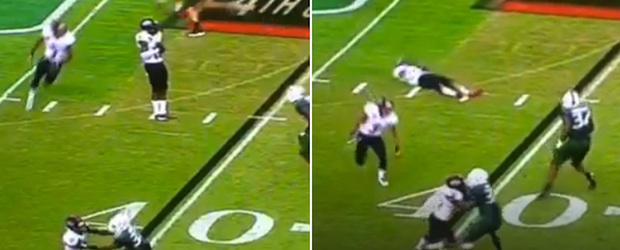 Like most of you, I didn’t even notice when it happened. It wasn’t until the next Tuesday, September 16th, when I casually perused my Twitter feeds, did something unusual about A-State’s 41-20 loss to Miami begin to surface.
Like most of you, I didn’t even notice when it happened. It wasn’t until the next Tuesday, September 16th, when I casually perused my Twitter feeds, did something unusual about A-State’s 41-20 loss to Miami begin to surface.
“Arkansas State Attempted the Worst Fake Punt We’ve Ever Seen” trumpeted a headline from SB Nation.
“Arkansas State Player Plays Dead During Fake Punt, Gets Lit Up” thundered Bleacher Report.
“Arkansas State Player Pretends To Die On Fake Punt, For Some Reason,” lambasted Deadspin.
A few news outlets were kinder. CBSSports dubbed WR Booker Mays, the lead actor of the Fainting Goat, an “internet sensation.” Sports Illustrated actually reached out to Coach Blake Anderson for an explanation. Most outlets chose to run with SB Nation’s take: that the play was a ridiculous, worthless, goofball failure of play. “For some reason, we don’t think the “fall over dead” fake punt has a future in college football,” announced SB Nation, presumably while polishing a monocle.
But no matter how the Faint Punt was portrayed, either negatively or positively, it cannot be denied that the failed trick play dominated sports blogs and social media outlets for days, giving A-State a recognition not gained by an ordinary 21-point defeated. You can find it everywhere: ESPN, USA Today, NFL.com and Fox Sports all carried the story. It even inspired this brilliant 30 for 30 parody.
Some of us, me included, were compelled by social media pressure to defend the Faint Punt. It was criticized for being more an immature stunt than a serious attempt at yards. Its biggest crime was that it simply didn’t work. (Perhaps if kicker Luke Ferguson were a better passer than a punter, things might have turned out differently.)
It didn’t help that the video most viewed was edited (unintentionally) so that it appeared that Mays was “blown up” and “flattened” by a Miami defender, as the 8-second Vine suggests. In reality, Mays takes a standard hit and is never knocked off his feet. (You can actually see the full effect of the hit here.)
Lost in the initial discussion is that a trick play is exactly that – a trick. Critics seemed to place the execution of a fake punt on par with Operation Overlord. OMG! What would Knute Rockne say?
Also, what did A-State have to lose, exactly? There is risk inherent to any trick play, let alone one that involves feigned death. Situated in Miami territory, but located nowhere near Ferguson’s field goal range, conditions were ripe for tomfoolery. And given that Miami was already beginning to assert their will upon A-State’s secondary, why not try something different?
But what critics comprehended least was that failure or success of the play didn’t really rely on the thespian talents of Booker Mays. This is what Coach Anderson said in the Sports Illustrated Q&A:
“If (Mays “fainting) would have had anything to do with the success or failure of the play, then we wouldn’t have done it. That was a guy who had virtually no job on the play, so it was a great opportunity to have some fun with it.”
As you can see, while the Faint Punt failed to fool the Miami defense, it did manage to fool those who seemed to consider that such a play violated the hallowed integrity of straight-laced pigskin. But no such sin was committed. In fact, the fake punt A-State failed to execute from its own end zone against ULL was a far more egregious call by Anderson and Friends.
A-State fans are happy to forget that one.













